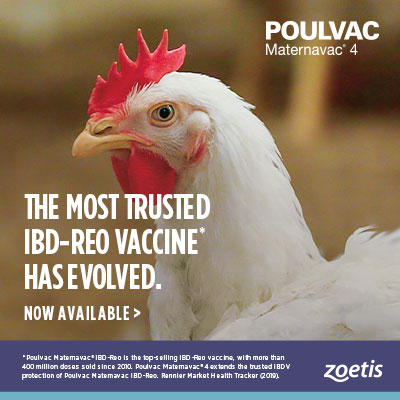New four-way broiler breeder vaccine builds on success of Maternavac name
An interview with Kalen Cookson, DVM, MAM, Director of Clinical Research, Zoetis
Q: Zoetis recently introduced Poulvac Maternavac® 4, a new inactivated vaccine to help protect against four important diseases. What’s noteworthy about the vaccine?
KC: The foundation for the vaccine is Poulvac Maternavac® IBD-Reo. Since 2010, the US poultry industry has used more than 400 million doses of that vaccine — more than any other commercial product of its kind.1 That’s quite a testament to the vaccine’s value.
Producers can rest assured the new vaccine, like its predecessor, will help protect primed broiler breeders against classic and variant strains of infectious bursal disease virus (IBDV) and malabsorption due to reovirus, but now the vaccine will also protect against the Newcastle and infectious bronchitis viruses.
Q: Does the new four-way vaccine protect broiler offspring?
KC: Maternal antibodies passed on by broiler breeders for IBDV, reovirus and Newcastle disease virus (NDV) will help protect broiler offspring. For infectious bronchitis virus (IBV), the vaccine is labeled to protect broiler breeders only.
Q: Reducing the number of injections broiler breeders need will reduce bird stress as well as labor costs, and those are real plusses, but protection against IBDV is of paramount importance. Could adding antigens for protection against other viruses interfere with the efficacy of Poulvac Maternavac 4 against IBDV?
KC: We’ve conducted rigorous studies to ensure protection against IBDV is as good with the new vaccine as it is with its predecessor.2 In fractional dose studies, which are standard in the industry for vaccine development, Poulvac Maternavac IBD-Reo and Poulvac Maternavac 4 both provided 100% protection against a challenge with AL2 — the most prominent IBDV strain — and at least 95% protection against the Delaware-E strain.
Q: How does Poulvac Maternavac 4 stack up against other comparable four-way broiler breeder vaccines on the market?
KC: We also compared the new vaccine to three comparable four-way products in another fractional dose study. In this study, Poulvac Maternavac 4 provided the best, most consistent immune response to challenges with IBDV variants AL2 and the two most common AL2-like isolates — we simply call them AL2-b and AL2-c.3 The results are based on percent protection and ELISA titers determined 10 days after challenge4 (Table 1).

Notes: Treatments within a column that share a letter are not significantly different (P ≤ 0.05). B:BW is the bursa to bodyweight ratio.
[CLICK TABLE TO ENLARGE]
Q: What about protection against reovirus with the new four-way vaccine?
KC: Seroconversion in the comparative study demonstrated that Poulvac Maternavac 4 and one of the three competitor vaccines gave the highest titers for reovirus.
We’ve taken great care to balance the IBDV and reovirus antigens in Poulvac Maternavac 4 because we’ve found during vaccine development that if there’s an imbalance, the reovirus titer response tends to be too low.
Q: Is there anything unique about the new four-way compared to comparable products?
KC: Yes. The NDV antigen in the vaccine is the Kimber strain, and that’s unique. The Kimber strain is highly immunogenic and is important in areas where NDV has become a serious threat to commercial flocks. Besides protecting hens, maternal antibodies for NDV passed on by hens should help reduce reactions to live NDV vaccines given in the hatchery to broiler progeny.
Q: Let’s talk about the infectious bronchitis component. Why did Zoetis opt for the Massachusetts strain but did not also include an Arkansas strain?
KC: When pullets are properly primed with a live Arkansas vaccine — as most are — there is little benefit to adding an Arkansas IBV antigen into the inactivated four-way products.5 This allows us to invest more in antigens that directly benefit the progeny.
Q: What can producers expect from Poulvac Maternavac 4?
KC: They can expect the vaccine will help establish a strong foundation of immunity against four very costly diseases of poultry. Strong immunity is especially important nowadays with the increase in “no antibiotics ever” production since viruses predispose to bacterial infections.
1 Rennier Associates Inc., U.S. Broiler-Health Market Tracker, 2018.
2 Data on file. Study No. 032419-KL-70AQO-KC6020, Zoetis LLC.
3 Cookson K, Featherson S, Barker A, Schaeffer J. A survey of wild type IBDV isolated from broiler flocks in the United States since 2014. Proc. Southern Conference of Avian Diseases, Atlanta, GA. 2020.
4 Data on file. Study No. 040322-KC-70AQO-KC6121, Zoetis LLC.
5 Cookson K, et al. A comparison of 46-week serology and IBV Arkansas protection in flocks receiving different commercial SE bacterins. 66th Western Poultry Disease Conference. 2017,
TOOLBOX, Issue 20
Toolbox is a series of interviews with veterinarians and other technical specialists about their experiences managing antimicrobials, vaccines and other tools for poultry health. It is produced by the editors of Poultry Health Today on behalf of the US Poultry Business of Zoetis.
BIO-00228
June 2020
Posted on September 24, 2020















